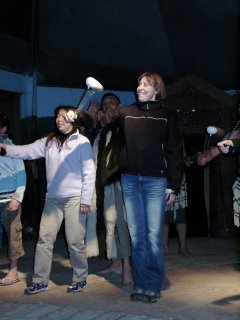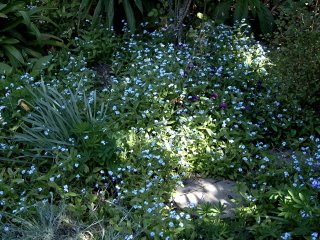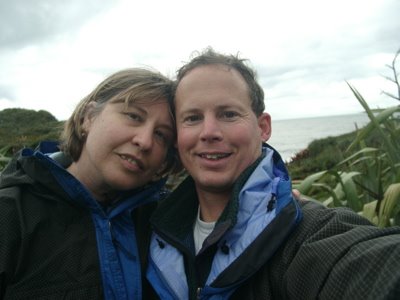Wandering Willowbank
The Willowbank Wildlife Reserve, located on the outskirts of Christchurch, is not simply another reserve, but strives to link the local animals and the Maoris who first inhabited this land. There are many endemic and introduced animals on display.

This curly feathered goose is apparently one of the most threatened species of endemic goose. I thought it was cool. I have never seen a goose with curly feathers!

The pukeko (Porphyrio porphyrio) is a native swamphen the locals refer to as the New Zealand chicken - not to be confused with the chook, which is Kiwi for chicken. These birds have beautiful iridescent bluish black feathers and bright red beaks and are often seen walking dangerously close to roadsides and in pastures on the outskirts of town. Even though these are beautiful birds, they are allowed to be hunted. There are some folks who worry these birds may be endangered by the prolific hunting. Recent articles report these birds are often shot and just left there :-(

Mother ducks with their broods have been a common sight this spring. The ducks seem to inhabit the most "citified" places and can often be found waddling along residential streets. Unfortunately, even though the mother duck can fly, their ducklings cannot, so when the duck wants to cross a street with her ducklings she walks with them across the road. We have watched mother ducks with a long line of ducklings cross even in front of buses - the bus drivers waits patiently for the ducks to cross before proceeding. However, we have seen many ducks that were hit on the road.

The Willowbank Wildlife Reserve serves as a way station for animals which have been injured. They nurture them back to health and even release them back into the wild if possible. One neat exhibit is mostly devoted to keas. They have about 10 kea or so (again, mostly those birds which they have nursed back to health and are in the recovery stage. These parrots are big and beautiful.

One female kea was particularly friendly and liked to fly over and land on people's shoulders. Later in the evening we took a guided tour of the native section of the reserve and we were in for a treat as the guide opened a cup of honey and spooned the honey out to give to the keas!

My favorite area was the kiwi house. The reserve cares for many injured kiwis as well as rearing young chicks from the wild until they are of sufficient size to defend themselves against predators. This is by far the best kiwi house I have seen yet. The pens do not have glass or wire mesh surrounding them as most other kiwi house do. Visitors can get a great view of the kiwis in their "native" environment, waddling around poking their long beaks into the ground and through leaves looking for worms and insects - very cool. We saw perhaps 6 kiwis inside the enclosure. They also have outdoor enclosure which would be great to visit at or after dusk.
Within the native portion of the reserve they have built a replica Maori village, or pa. As part of our tour we encountered a group of Maori in native attire and were greeted the traditional way - with a very aggressive show of warrior strength and language as well as the swinging of their great stone clubs and spears! Luckily our appointed "leader" chose not to intimidate these folks and we were allowed to enter their village to learn how the Maori pa was laid out - very interesting.

After our tour of the native animals and the pa we were led to a small amphitheatre and treated to a group of Maori who related a bit of their culture through dancing and singing. Because it was the off season and there were only a handful of visitors there, we were then all forced into a bit of dancing ourselves. The women perform a dance called the poi utilizing a small ball tied to the end of a string which is swirled around in different positions throughout the dance. The folks there indicated the poi - a ball tied onto string - may have either been used to "tuffen up" the women who repeatedly strike their forearms with the ball while they dance or they may have been used as weapons. I am not sure which is correct.
The men perform a dance called the haka, and yes, I did indeed have to dance the haka with the rest of the guys in our group - ugh! Probably the most famous haka in the world is performed by the New Zealand All Blacks rugby team. If you have ever seen their intimidating dance before a rugby team you have seen a haka.

After our humbling dance experience we were led to a nice dining room and were treated to a buffet including carved pork, beef, and lamb, as well as all the necessary scrumptious vege dishes! I even had my first opportunity to try a standard Kiwi dessert, pavlova. Pavlova is essentially a pie made of sweetened meringue - a bit too sweet for my taste.
The reserve is open until late in the evening during the summer and it would be worth it to check it out in the evening sometime.
"We watched the Maori dance with glee/
But the haka is not for me."

This curly feathered goose is apparently one of the most threatened species of endemic goose. I thought it was cool. I have never seen a goose with curly feathers!

The pukeko (Porphyrio porphyrio) is a native swamphen the locals refer to as the New Zealand chicken - not to be confused with the chook, which is Kiwi for chicken. These birds have beautiful iridescent bluish black feathers and bright red beaks and are often seen walking dangerously close to roadsides and in pastures on the outskirts of town. Even though these are beautiful birds, they are allowed to be hunted. There are some folks who worry these birds may be endangered by the prolific hunting. Recent articles report these birds are often shot and just left there :-(

Mother ducks with their broods have been a common sight this spring. The ducks seem to inhabit the most "citified" places and can often be found waddling along residential streets. Unfortunately, even though the mother duck can fly, their ducklings cannot, so when the duck wants to cross a street with her ducklings she walks with them across the road. We have watched mother ducks with a long line of ducklings cross even in front of buses - the bus drivers waits patiently for the ducks to cross before proceeding. However, we have seen many ducks that were hit on the road.

The Willowbank Wildlife Reserve serves as a way station for animals which have been injured. They nurture them back to health and even release them back into the wild if possible. One neat exhibit is mostly devoted to keas. They have about 10 kea or so (again, mostly those birds which they have nursed back to health and are in the recovery stage. These parrots are big and beautiful.

One female kea was particularly friendly and liked to fly over and land on people's shoulders. Later in the evening we took a guided tour of the native section of the reserve and we were in for a treat as the guide opened a cup of honey and spooned the honey out to give to the keas!

My favorite area was the kiwi house. The reserve cares for many injured kiwis as well as rearing young chicks from the wild until they are of sufficient size to defend themselves against predators. This is by far the best kiwi house I have seen yet. The pens do not have glass or wire mesh surrounding them as most other kiwi house do. Visitors can get a great view of the kiwis in their "native" environment, waddling around poking their long beaks into the ground and through leaves looking for worms and insects - very cool. We saw perhaps 6 kiwis inside the enclosure. They also have outdoor enclosure which would be great to visit at or after dusk.
Within the native portion of the reserve they have built a replica Maori village, or pa. As part of our tour we encountered a group of Maori in native attire and were greeted the traditional way - with a very aggressive show of warrior strength and language as well as the swinging of their great stone clubs and spears! Luckily our appointed "leader" chose not to intimidate these folks and we were allowed to enter their village to learn how the Maori pa was laid out - very interesting.

After our tour of the native animals and the pa we were led to a small amphitheatre and treated to a group of Maori who related a bit of their culture through dancing and singing. Because it was the off season and there were only a handful of visitors there, we were then all forced into a bit of dancing ourselves. The women perform a dance called the poi utilizing a small ball tied to the end of a string which is swirled around in different positions throughout the dance. The folks there indicated the poi - a ball tied onto string - may have either been used to "tuffen up" the women who repeatedly strike their forearms with the ball while they dance or they may have been used as weapons. I am not sure which is correct.
The men perform a dance called the haka, and yes, I did indeed have to dance the haka with the rest of the guys in our group - ugh! Probably the most famous haka in the world is performed by the New Zealand All Blacks rugby team. If you have ever seen their intimidating dance before a rugby team you have seen a haka.

After our humbling dance experience we were led to a nice dining room and were treated to a buffet including carved pork, beef, and lamb, as well as all the necessary scrumptious vege dishes! I even had my first opportunity to try a standard Kiwi dessert, pavlova. Pavlova is essentially a pie made of sweetened meringue - a bit too sweet for my taste.
The reserve is open until late in the evening during the summer and it would be worth it to check it out in the evening sometime.
"We watched the Maori dance with glee/
But the haka is not for me."










